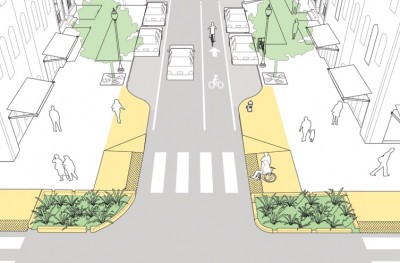
Bridgeport Mayor Bill Finch announced this week that the city is launching a comprehensive safe streets initiative. Seven pedestrians have been killed by drivers in Bridgeport since 2010. Bridgeport is the second Connecticut city to announce a street safety campaign in as many months. In September, Stamford Mayor David Martin unveiled the Stamford Street Smart campaign.
At first blush, the two efforts appear to have a lot in common. Mayor Finch — who participated in a walking audit with Tri-State in 2013 — described Bridgeport’s campaign as a “multipronged approach” focused on education, enforcement and investment, while Mayor Martin called Stamford Street Smart a “multi-faceted approach” that focuses on education, enforcement and engineering. Both campaigns began with crackdowns on distracted driving, and both include efforts to curb so-called “jaywalking.”
Both Bridgeport and Stamford also plan to address the physical condition of their streets, but how they’ll go about doing so is where there’s a more distinct difference between the two initiatives.
The engineering component of Stamford Street Smart is somewhat limited. Making sure signs are visible at intersections, re-painting crosswalks and synchronizing traffic signals are certainly good ideas, but not something to brag about. In other cities, these measures would be considered part of regular maintenance.
In Bridgeport, however, there’s already talk about making physical changes that have been proven to calm traffic, such as roundabouts and curb extensions. And moving forward, the City will start to integrate traffic calming into its regular maintenance:
“As we repave or redesign roadways, we will collaborate with the engineering department, the traffic engineer and the police department to see if we can incorporate traffic calming measures into the design,” said Public Facilities Director Jorge Garcia.
We’re eager to see how Bridgeport moves forward with its traffic calming plans, and hope that Stamford’s Street Smart initiative will evolve to include a more ambitious approach to improving streets for pedestrians and bicyclists (an updated master plan and a pending Complete Streets ordinance are reasons to be optimistic).
Connecticut cities have, with a few exceptions, struggled to keep up with the latest in pedestrian- and bike-friendly street design. And while it’s encouraging to see the state’s three most populous municipalities tackling safety issues with targeted enforcement and educational campaigns, the most walkable, bike-friendly communities are the ones where streets are designed to safely accommodate all users — not where police write the most tickets.

[…] For more on this story, visit: With Investments in Traffic Calming and Street Redesigns, Bridgeport’s Safety Campaign Shows Promi…. […]
[…] like something you’d see in a suburban office park, and Stamford’s new Street Smart program doesn’t address the downtown area’s wide arterials that shun pedestrians and […]